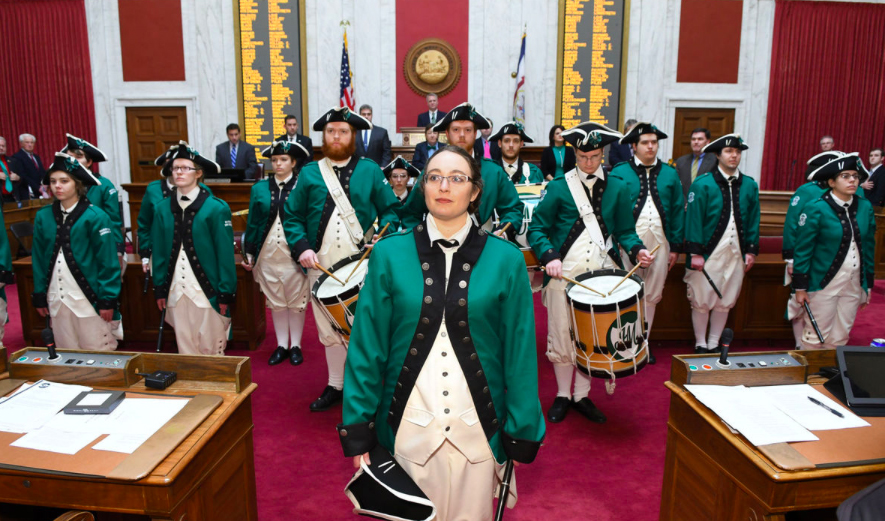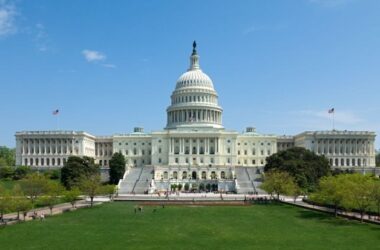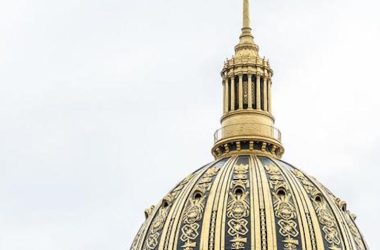By LACIE PIERSON
The Herald-Dispatch
CHARLESTON, W.Va. — Standing on white marble underneath a blue-and-gold dome, Marshall University students, faculty and staff donned their kelly green and brought the university’s culture, credo and history to Charleston on Thursday during Marshall University Day at the West Virginia Capitol.

(WV Legislature photo)
Marshall Day annually is a chance for representatives of every entity in the university to showcase their work to legislators, which has a special significance this year as higher education institutions throughout the state work to avoid another year of budget cuts.
This year’s Marshall Day marks the first year the day was celebrated under a West Virginia governor whose higher education degrees come only from Marshall.
“I owe a lot of my life to Marshall University,” Justice said. “I’ve got a love for Marshall that goes really deep. I followed my high school sweetheart to Marshall, and I went to Marshall. We’ve been married 40 years now, and we’ve got two beautiful children, one that’s a Marshall grad and a doctor. The long and the short of it is we go way back.”

In addition to Justice, other notable Marshall figures including head football coach Doc Holliday, the John Marshall Fife and Drum Corps and mascot Marco had their turns in front of the legislature with resolutions approved in the House of Delegates and the Senate.
For every $1 the state invests in Marshall, it receives a $20 return, said Ginny Painter, senior vice president of marketing and communications at Marshall.
“Marshall employs 1,000 people directly, but we also have an impact in the number of jobs in our community that’s over 3,000 jobs we affect,” Painter said. “We have an almost $400 million economic impact on our region, and that’s a really important story for legislators and the governor’s office to hear because they often don’t get to think about what the return is.”
Painter also noted the significance of having a Marshall graduate leading the executive branch of state government.
“It’s always special to have a son or daughter of Marshall in the governor’s office,” Painter said. “The Marshall family is very strong, and we stick together. It’s good to have that friendly face here and to have someone who knows that Marshall history in the office.”
Emily Kinner, of Barboursville, is Marshall’s student body vice president. Kinner is majoring in broadcast journalism and political science, a path that led her to an internship at the legislature in 2016.
On Thursday, she said she was glad to get to represent her alma mater again at the state Capitol.
“It’s always great to be here, especially when you get to represent your school colors,” Kinner said. “It sounds cheesy, but we really are a family. Marshall’s a close-knit community, and we have a lot of love for each other and show that love all around. I’m really thankful and proud to go to Marshall.”
Even though there was a strong Marshall presence at the Capitol, a noticeable absence was that of Marshall President Jerome “Jerry” Gilbert.
“Everyone told him this was a once-in-a-lifetime opportunity for him to be honored,” Painter said. “He wavered about whether he should go, but I think it shows what a scholar and a leader that we have for a president that he’s being honored that way at his alma mater.”
Even without Gilbert, Painter said university representatives put on a good showing and worked to sway legislators to find cost-saving measures other than cutting higher education.
Marshall has lost $11.5 million in annual base funding from the state in consecutive years of budget cuts. Gilbert along with other higher education leaders in the state have pleaded with legislators to avoid taking more from them to balance a nearly $500 million shortfall in the 2018 budget.
At the start of the legislative session, Justice proposed targeted state funding cuts to Marshall and West Virginia University, but he has since backed off, saying he’d accept up to $50 million in cuts anywhere in the state budget if legislators meet him halfway on proposed tax increases.
On Thursday, Justice said he was actively working to avoid making additional cuts to higher education.
“I’m standing as firm as I possibly can in trying to prevent substantial cuts to higher education,” Justice said. “There’s a group that really wants to take a meat ax to higher ed, and I think it’d be a terrible mistake. They’re going to have to go through me to get it done.”
See more from The Herald-Dispatch






